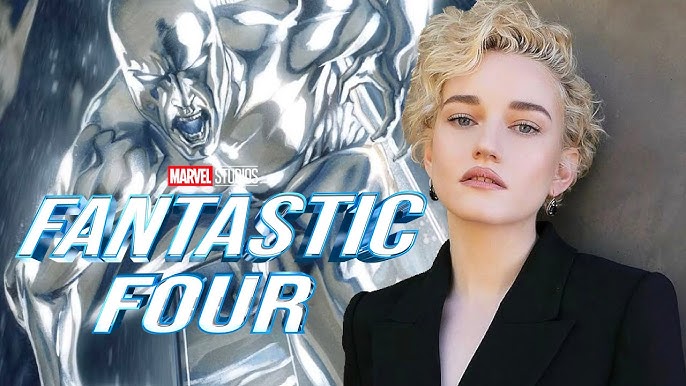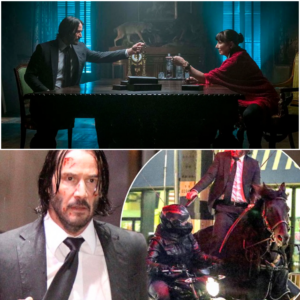
When Marvel Studios dropped the first trailer for The Fantastic Four: First Steps at CinemaCon on April 3, 2025, fans expected a visual feast, especially with the MCU’s cutting-edge technology at play. The debut of Julia Garner’s Silver Surfer (Shalla-Bal) was a highlight, but instead of universal praise, it sparked a surprising debate: why does the CGI for the Silver Surfer in 2007’s Fantastic Four: Rise of the Silver Surfer—a film now 18 years old—look “better” to many fans than its 2025 counterpart? Social media platforms like X lit up with sentiments like, “How the hell does 2007 Silver Surfer still look much better lol?” This article dives into the evolution of CGI, compares the two Silver Surfers, and explores why fans are rallying behind a nearly two-decade-old effect over modern advancements, drawing from web insights and fan discussions.
The 2007 Silver Surfer: A CGI Triumph of Its Time
In Fantastic Four: Rise of the Silver Surfer (2007), directed by Tim Story, the Silver Surfer (Norrin Radd), portrayed through motion capture by Doug Jones and voiced by Laurence Fishburne, was a visual standout. The character’s sleek, reflective metallic body and iconic surfboard were crafted with a blend of practical effects and CGI, a choice that lent authenticity to his otherworldly presence. The Surfer’s design was faithful to Jack Kirby’s comics, with a smooth, mirror-like surface that caught light realistically for the era. As ScreenRant notes, “The design may look dated by contemporary standards in special effects (though not by much), but it was a surprisingly faithful recreation of the source material.”
The 2007 CGI, while not flawless, excelled in simplicity. The Surfer’s clean lines and minimalistic design didn’t require overly complex textures or lighting, allowing the effects team to focus on his reflective quality. Collider praises the “comic-accurate” look, noting that Jones’ motion capture added a human fluidity that made scenes like the Surfer’s chase with the Human Torch (Chris Evans) feel dynamic. Budgeted at $120–130 million, the film leaned on Weta Digital for key sequences, using tools like Autodesk Maya and mental ray—industry standards at the time—to render the Surfer’s cosmic sheen. Fans on X echo this, with one user (@KnightsofTitan) stating, “The VFX on the Silver Surfer still hold up today.”
The Surfer’s board, a source of his power, was another highlight, seamlessly integrated into action scenes. Unlike today’s often overstuffed CGI, the 2007 effects avoided clutter, letting the Surfer’s elegance shine. A Reddit thread on r/boxoffice from 2022 lauded the “pretty sweet” CGI for its time, crediting Fishburne’s voice and the Surfer’s fluid movements for making him the film’s best part. This simplicity, paired with a grounded approach to lighting and physics, gave the 2007 Surfer a timeless quality that fans still celebrate.
The 2025 Silver Surfer: A Modern Marvel with Mixed Reactions
Fast-forward to 2025, and The Fantastic Four: First Steps introduces Shalla-Bal as the Silver Surfer, played by Julia Garner. The trailer reveals her descending from a dark sky, her reflective body and board gleaming with a haunting, alien aura. Designed to evoke a more otherworldly and unsettling presence, Shalla-Bal’s CGI leans into modern advancements: higher polygon counts, real-time ray tracing, and complex light interactions, likely powered by tools like Unreal Engine or updated Autodesk suites. ScreenRant describes her as “completely made up of a silver-like metallic substance,” with a design that shares similarities to the T-1000 from Terminator 2: Judgment Day, aiming to emphasize her cosmic strangeness.
Yet, despite the technological leap—18 years of progress in rendering power, motion capture, and VFX pipelines—some fans find Shalla-Bal’s CGI lacking. Posts on X capture the sentiment vividly: “How the hell does the silver surfer from 2007 look more realistic than the silver surfer in the 2025 movie?” (@I_Am_EDB) and “The CGI is lame in comparison with the original Silver Surfer from 2007, they should be fully metallic and she should be way more shiny” (@Warpingfist64). Critics argue her reflective skin appears “unsettling” or “out of place,” with eyes and mouth not blending seamlessly into the metallic form, unlike the 2007 Surfer’s smoother integration. Dexerto reports fans asking, “Why does the actual Silver Surfer from 2007 Fantastic Four look better than Julia Garner’s Silver Surfer (Shalla-Bal) in 2025?”
The 2025 design prioritizes an alien aesthetic over comic fidelity, which may explain the divide. Where Norrin Radd was a direct translation of Kirby’s vision, Shalla-Bal’s look draws from multiversal comics like Earth X, where she briefly becomes a Surfer. Her reflective surface interacts with light in a more dynamic, almost liquid-metal way, but this complexity can feel unnatural to viewers expecting the 2007 version’s polished simplicity. Newsweek notes that Garner’s Surfer serves as Galactus’ herald, warning of Earth’s doom, suggesting the CGI aims to amplify her eerie role rather than replicate past designs. Still, the polish of modern effects hasn’t won everyone over.
CGI Evolution: Progress or Overreach?
The debate raises a broader question: how far has CGI come? Between 2007 and 2025, visual effects have advanced dramatically. In 2007, Rise of the Silver Surfer used 32-bit rendering and relied on physical sets for many scenes, with CGI reserved for characters like the Surfer and Galactus’ cloud form. ShotOnWhat lists tools like Autodesk Maya and mental ray, which were cutting-edge but limited by processing power. By 2025, studios leverage 64-bit systems, real-time rendering, and AI-driven VFX, as seen in films like Avatar: The Way of Water (2022), which set new benchmarks for photorealism. The Fantastic Four: First Steps, with a reported $200 million budget, likely uses these tools to create Shalla-Bal’s intricate reflections and cosmic environments.
However, progress doesn’t always equal perception. Modern CGI often aims for hyperrealism or stylized complexity, which can backfire if it feels artificial. The 2007 Surfer benefited from its straightforward design—less room for error when rendering a smooth, metallic humanoid. As IGN reflects, “Jones and the special effects team have done an admirable job in bringing the iconic character faithfully to the screen.” In contrast, Shalla-Bal’s design pushes for an alien, almost uncanny effect, which ScreenRant defends as “intentionally unsettling” to highlight her otherness. Fans accustomed to the 2007 look, though, see this as a step back, with one X user (@buggy_con) exclaiming, “Welp the 2005 Silver Surfer has better CGI compared to something that came out 20 fucking years later.”
Another factor is nostalgia. Rise of the Silver Surfer’s Surfer was a cultural moment, lauded as the film’s saving grace despite mixed reviews (38% on Rotten Tomatoes). Its CGI, while dated in resolution, feels “right” because it matched expectations set by comics. Shalla-Bal’s departure—both in gender and design—faces scrutiny not just for technical execution but for diverging from that memory. Collider argues the 2007 Surfer’s “isolated nature” and comic accuracy made him a standout, while 2025’s version risks alienating fans by prioritizing a new vision.
Why Fans Prefer 2007: Simplicity and Fidelity
Several reasons explain why fans hold the 2007 Silver Surfer in higher regard:
Comic Accuracy: Norrin Radd’s design was a near-perfect translation of Kirby’s art—sleek, reflective, and humanoid. Shalla-Bal’s more alien look, while innovative, feels less tethered to the classic Surfer, prompting comments like, “They should be fully metallic and way more shiny” on X.
Practical Roots: Doug Jones’ motion capture and partial practical suit added a tangible quality. MovieWeb reveals a behind-the-scenes photo of Jones in a silver suit, proving “the Surfer was more than just a CGI creation.” Modern CGI, often fully digital, can lack this grounded feel, as seen in complaints about Shalla-Bal’s “unrealistic” eyes and mouth.
Simpler Execution: The 2007 Surfer avoided overcomplicating textures or lighting, focusing on a mirror-like finish that aged well. ScreenRant admits the 2007 effects aren’t modern but “hold up rather well” due to their clarity. Shalla-Bal’s dynamic reflections, while technically advanced, can appear jarring if not perfectly balanced.
Emotional Impact: The 2007 Surfer’s story—his sacrifice against Galactus—resonated deeply, amplified by Fishburne’s voice and Jones’ expressive movements. Fans on Reddit recall “loving him in school,” tying the CGI’s success to the character’s emotional pull. Shalla-Bal’s brief trailer appearance hasn’t yet matched this connection, leaving her visuals to stand alone under scrutiny.
The Bigger Picture: CGI’s Double-Edged Sword
The fan preference for 2007’s Silver Surfer doesn’t mean CGI hasn’t progressed. Modern effects enable sprawling battles, photoreal creatures, and seamless world-building, as seen in Avengers: Endgame or Dune: Part Two. But complexity can overwhelm when simplicity would suffice. The Fantastic Four: First Steps still has months before its July 25, 2025, release, and VFX refinements could address fan concerns, as one X user hopefully noted: “They do still have a few months so maybe they’ll fix it up.” Yet, the 2007 Surfer’s enduring appeal lies in its restraint—proof that “better” CGI isn’t always about more polygons but about capturing a character’s essence.
The debate also reflects broader VFX trends. Studios now face pressure to deliver spectacle, sometimes at the cost of coherence. The Hollywood Reporter critiques modern films for “CGI overload,” where details drown out impact. The 2007 Surfer, with its focused design, dodged this trap, earning praise like “pretty sweet for the time” from fans. Shalla-Bal’s CGI, while ambitious, may suffer from trying too much too soon, especially in a trailer meant to tease rather than finalize.
Conclusion: A Tale of Two Surfers
So, how far has CGI come? Miles in technology, but not always in fan perception. The 2007 Silver Surfer in Fantastic Four: Rise of the Silver Surfer remains a benchmark for its comic fidelity, practical grounding, and elegant simplicity, qualities that make it “look better” to many despite 2025’s superior tools. Julia Garner’s Shalla-Bal in The Fantastic Four: First Steps pushes for a bold, alien aesthetic, but its complexity and departure from tradition have fans looking back fondly at Norrin Radd’s gleaming form. As First Steps nears, Marvel has a chance to polish Shalla-Bal’s shine, but for now, the 2007 Surfer rides high on nostalgia and craft. Catch the cosmic clash when The Fantastic Four: First Steps lands in theaters on July 25, 2025—and see which Surfer ultimately wins your heart.




